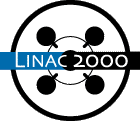
Robert L. Kustom (SNS/ORNL)
The Spallation Neutron Source (SNS) is being designed, constructed, installed and commissioned by the staff of six national laboratories, Argonne National Laboratory, Brookhaven National Laboratory, Jefferson National Accelerator Laboratory, Lawrence Berkeley National Laboratory, Los Alamos National Laboratory, and Oak Ridge National Laboratory. The accelerator systems are designed to deliver a 695 ns proton-pulse onto a mercury target at a 60-Hz repetition rate and an average power of 2-MW. Neutron moderators that will convert the spallation neutrons into slow neutrons for material science research will surround the target. Eighteen neutron beam lines will be available for users, although initially, only 10 instruments are planned. The Front-End systems are designed to generate an H- beam of minipulses, 68% beam on, 32% beam off every 965 ns, at 2.5 MeV for 1 ms, 60 times a second. The Front-End systems include a RF driven, volume-production ion source, beam chopping system, RFQ, and beam transport. The ion source will have to achieve about 65 mA to deliver 52 mA at the input to the linac. The linac consists of a drift tube linac up to 86.8 MeV, a coupled-cell linac to 185 MeV, and a superconducting RF linac to the nominal energy of 1 GeV. The design of the superconducting section includes 11 cryomodules with three, 0.61-beta cavities per cryomodule and 17 cryomodules with four, 0.81-beta cavities per cryomodule, with space to install four more 0.81-beta cryomodules. The accumulator ring is designed for charge exchange injection at full energy. The peak charge per bunch at the end of the accumulation cycle will reach 2.08x10**14 for 2-MW operation. The goal is to control beam losses to less than 1x10**-4. A detailed overview of the accelerator systems and progress at the various laboratories will be presented.
Comments or Questions to
linac2000@slac.stanford.edu